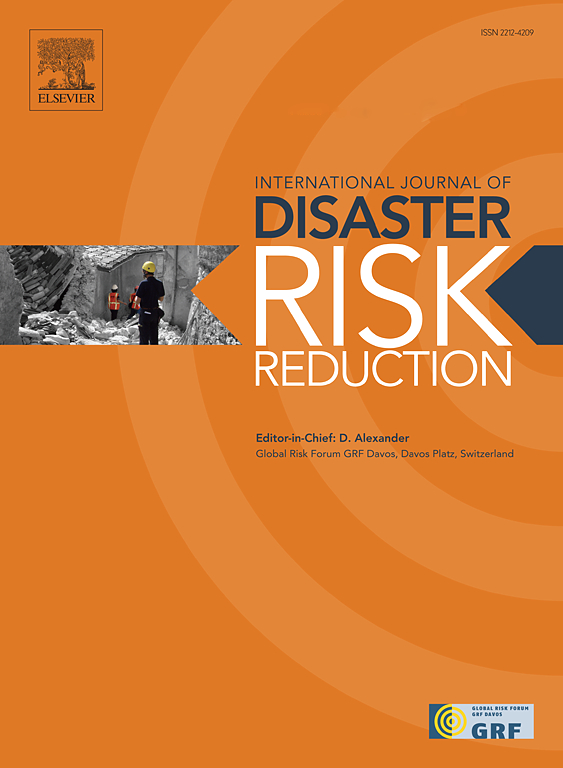定量评估降雨-洪水灾害下的拥堵扩散和连带效应:中国南京案例研究
IF 4.2
1区 地球科学
Q1 GEOSCIENCES, MULTIDISCIPLINARY
International journal of disaster risk reduction
Pub Date : 2024-10-21
DOI:10.1016/j.ijdrr.2024.104915
引用次数: 0
摘要
城市道路网络经常受到降雨-洪水灾害的干扰,这会造成严重的交通中断,并因连锁效应而导致交通拥堵。本文研究了降雨-洪水条件下的可靠性问题。本文提出了一个将降雨-洪水模型与改进的级联故障模型相结合的耦合模型,以评估降雨强度和洪水将如何影响交通拥堵并带来网络不稳定性。利用改进的非线性负载-容量模型,我们量化了交通拥堵的影响,并分析了各种降雨-洪水条件下的级联过程。中国南京的案例研究表明,当拥堵导致网络压力超过交通渗透阈值时,交通拥堵扩散会变得更加明显,给其他可通行道路带来过大压力。交通拥堵扩散导致的网络级联故障会使剩余的可通行道路过度集中,导致平均重要性急剧上升。这项工作的意义在于提供了一种有效的方法,可以提前预测潜在的网络中断和级联故障,从而加强灾后道路运营。本文章由计算机程序翻译,如有差异,请以英文原文为准。
Quantitative assessment of congestion diffusion and cascading effect under rainfall-flood disasters: A case study of Nanjing, China
Urban road networks are frequently disrupted by flooding rainfall-flood disasters, which can cause severe traffic disruptions and leading to traffic congestion due to cascading effect. This paper investigates the reliability issues under rainfall-flood conditions. A coupled model, integrating a rainfall-flood model with an improved cascading failure model, is proposed to assess how rainfall intensities and flooding will influence traffic congestion and bring network instability. Utilizing an improved Nonlinear Load-Capacity model, we quantify the impact of congestion and analyze cascading processes under various rainfall-flood conditions. The case study in Nanjing, China reveal that, when congestion causes network pressure to exceed the traffic percolation threshold, traffic congestion diffusion becomes more pronounced, putting excessive strain on other passable roads. Network cascading failures due to traffic congestion diffusion can lead to excessive focus on the remaining passable roads, resulting in a sharp increase in the average importance. The significance of this work lies in its provision of an effective method for predicting potential network disruptions and cascading failures in advance, thereby enhancing post-disaster road operations.
求助全文
通过发布文献求助,成功后即可免费获取论文全文。
去求助
来源期刊

International journal of disaster risk reduction
GEOSCIENCES, MULTIDISCIPLINARYMETEOROLOGY-METEOROLOGY & ATMOSPHERIC SCIENCES
CiteScore
8.70
自引率
18.00%
发文量
688
审稿时长
79 days
期刊介绍:
The International Journal of Disaster Risk Reduction (IJDRR) is the journal for researchers, policymakers and practitioners across diverse disciplines: earth sciences and their implications; environmental sciences; engineering; urban studies; geography; and the social sciences. IJDRR publishes fundamental and applied research, critical reviews, policy papers and case studies with a particular focus on multi-disciplinary research that aims to reduce the impact of natural, technological, social and intentional disasters. IJDRR stimulates exchange of ideas and knowledge transfer on disaster research, mitigation, adaptation, prevention and risk reduction at all geographical scales: local, national and international.
Key topics:-
-multifaceted disaster and cascading disasters
-the development of disaster risk reduction strategies and techniques
-discussion and development of effective warning and educational systems for risk management at all levels
-disasters associated with climate change
-vulnerability analysis and vulnerability trends
-emerging risks
-resilience against disasters.
The journal particularly encourages papers that approach risk from a multi-disciplinary perspective.
 求助内容:
求助内容: 应助结果提醒方式:
应助结果提醒方式:


